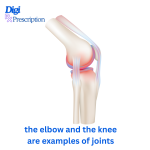
The human body is a marvel of design, with a vast network of joints that allow us to move, bend, stretch, and perform countless activities every day. Among these, the elbow and the knee are two of the most essential joints that we rely on for basic mobility. Although they serve different functions in our body, both the elbow and the knee share common characteristics, making them fascinating examples of joint anatomy.
Let’s take a closer look at these two joints, how they function, and why they are so important for our movement.
Key Features of the Elbow:
-
Movement: The primary movement is flexion and extension, with a secondary rotation that allows the forearm to turn (supination and pronation).
-
Ligaments: Key ligaments like the ulnar collateral ligament (UCL) and radial collateral ligament (RCL) provide stability.
The elbow plays an important role in almost every upper-body movement, from lifting objects to throwing, typing, and performing daily tasks like brushing your teeth or carrying groceries.
The knee is also a synovial hinge joint, but it is much larger and more complex than the elbow. It connects the femur (thigh bone) to the tibia (shin bone) and is supported by ligaments, tendons, and muscles to enable both flexion and extension, as well as
Key Features of the Knee:
-
Bones: The knee joint involves the femur, tibia, and patella (kneecap).
-
Movement: The knee allows for flexion and extension (bending and straightening) with limited rotational movement.
-
Ligaments: Crucial ligaments like the anterior cruciate ligament (ACL), posterior cruciate ligament (PCL), medial collateral ligament (MCL), and lateral collateral ligament (LCL) keep the knee stable.
-
Muscles: The quadriceps help extend the knee, while the hamstrings help flex it.
It plays a crucial role in walking, running, jumping, squatting, and other activities involving lower-body movement.
While the elbow and knee differ in size, location, and function, they share a few important characteristics:
-
Hinge Functionality: Both are hinge joints, allowing movement in one direction (flexion and extension).
-
Ligament Support: Both joints have multiple ligaments that provide stability and prevent excessive movement that could cause injury.
-
Muscle Interaction: The movement of both joints relies heavily on the muscles of the arms (elbow) or legs (knee) to facilitate the necessary action, whether it’s bending, straightening, or supporting the body’s weight.
-
Common Injuries: Elbow and knee joints are both prone to overuse injuries, strains, sprains, and more serious conditions like arthritis or ligament tears.
⚖️ Elbow vs. Knee: Key Differences
Though the elbow and knee share similarities, they also have key differences:
-
Weight-Bearing: The knee bears most of the body’s weight during standing and walking, while the elbow supports less weight and is more focused on mobility.
-
Complexity: The knee is more complex due to its involvement in weight-bearing and its reliance on several ligaments and muscles for stabilization, whereas the elbow's movement is more straightforward, involving fewer structures.
-
Range of Motion: The elbow has a more limited range of motion (flexion and extension only) compared to the knee, which can also rotate slightly when bent.
Both the elbow and knee joints are critical for everyday function, each playing a unique role in facilitating movement. Whether it’s the precision of your elbow for fine motor tasks or the strength of your knee for walking and running, understanding their anatomy and function helps us appreciate the complexity of the human body.
Proper care and attention are necessary to keep these joints healthy and functional for as long as possible. If you experience pain or discomfort in either joint, it’s important to consult a healthcare provider for diagnosis and treatment.
References
-
Cleveland Clinic – Knee Anatomy and Function
https://my.clevelandclinic.org/health/diseases/21788-knee -
Mayo Clinic – Elbow Pain and Injury
https://www.mayoclinic.org/diseases-conditions/elbow-pain/ -
Johns Hopkins Medicine – Knee Anatomy and Injuries
https://www.hopkinsmedicine.org/health/conditions-and-diseases/knee-injuries -
StatPearls – Elbow and Knee Joint Anatomy
https://www.ncbi.nlm.nih.gov/books/NBK536909/
